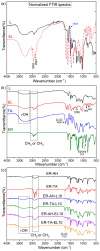Bio-Epoxy Resins Based on Lignin and Tannic Acids as Wood Adhesives-Characterization and Bonding Properties
- PMID: 39339066
- PMCID: PMC11435416
- DOI: 10.3390/polym16182602
Bio-Epoxy Resins Based on Lignin and Tannic Acids as Wood Adhesives-Characterization and Bonding Properties
Abstract
The possibility of producing and designing bio-epoxides based on the natural polyphenol lignin/epoxidized lignin and tannic acids for application as wood adhesives is presented in this work. Lignin and tannic acids contain numerous reactive hydroxyl phenolic moieties capable of being efficiently involved in the reaction with commercial epoxy resins as a substitute for commercial, non-environmentally friendly, toxic amine-based hardeners. Furthermore, lignin was epoxidized in order to obtain an epoxy lignin that can be a replacement for diglycidyl ether bisphenol A (DGEBA). Cross-linking of bio-epoxy epoxides was investigated via FTIR spectroscopy and their prospects for wood adhesive application were evaluated. This study determined that the curing reaction of epoxy resin can be conducted using lignin/epoxy lignin or tannic acid. Tensile shear strength testing results showed that lignin and tannic acid can effectively replace amine hardeners in epoxy resins. Examination of the failure of the samples showed that all samples had a 100% fracture through the wood. All samples of bio-epoxy adhesives displayed significant tensile shear strength in the range of 5.84-10.87 MPa. This study presents an innovative approach to creating novel cross-linked networks of eco-friendly and high-performance wood bio-adhesives.
Keywords: bio-epoxides; bio-hardener; epoxy lignin; lignin; tannic acid; tensile shear strength.
Conflict of interest statement
The authors declare no conflicts of interest.
Figures








References
-
- Salazar J., Meil J. Prospects for Carbon-Neutral Housing: The Influence of Greater Wood Use on the Carbon Footprint of a Single-Family Residence. J. Clean. Prod. 2009;17:1563–1571. doi: 10.1016/j.jclepro.2009.06.006. - DOI
-
- Islam M.N., Rahman F., Das A.K., Hiziroglu S. An Overview of Different Types and Potential of Bio-Based Adhesives Used for Wood Products. Int. J. Adhes. Adhes. 2022;112:102992. doi: 10.1016/j.ijadhadh.2021.102992. - DOI
-
- Dunky M. Wood Adhesives Based on Natural Resources: A Critical Review: Part I. Protein-Based Adhesives. Rev. Adhes. Adhes. 2020;8:199–332.
-
- Dunky M. Wood Adhesives Based on Natural Resources: A Critical Review Part III. Tannin- and Lignin-Based Adhesives. Prog. Adhes. Adhes. 2021;6:383–530. doi: 10.1002/9781119846703.ch10. - DOI
-
- Petrie E.M. Epoxy Adhesive Formulations. McGraw-Hill; New York, NY, USA: 2005.
Grants and funding
LinkOut - more resources
Full Text Sources

